The Vertiv Edge Lithium-Ion 1500 VA UPS Review: Impeccable Power, Imposing Price
by E. Fylladitakis on April 22, 2022 11:00 AM EST- Posted in
- Cases/Cooling/PSUs
- UPS
- 1500VA
- Vertiv
- Li-Ion
Testing
| UPS Load Performance | |||||
| 10% | 25% | 50% | 75% | 100% | |
| Voltage Output (Vrms) | 230 | 230 | 230 | 230 | 230 |
| Frequency (Hz) | 50.05 | 50 | 50.05 | 50 | 50 |
| Transfer Time (ms) | 3.6 | 4.3 | 4.5 | 4.8 | 5.2 |
The basic electrical figures for the Vertiv Edge Lithium-Ion 1500 VA are excellent, with the transfer time beating even the manufacturer’s own specifications. Vertiv specifies that the Edge Lithium-Ion has a typical transfer time between 4 and 6 ms but we recorded transfer times below 4 ms during load loads. The output is always rock-solid at 230 V RMS and 50 Hz, regardless of the load.
The fan outputs 42.3 dB(A) while it is running at maximum speed. Vertiv has programmed a load-based control of the fan’s speed into the Edge Lithium-Ion, meaning that the fan will reduce its speed according to the load while the unit is running on batteries. This initially seemed like a nice approach, but the fan will always run at maximum speed while the unit is recharging its batteries. Therefore, if the unit operates at just 25% load and there is a ten-minute outage, the fan will be nearly silent for ten minutes during the outage and then will be running at maximum speed for nearly two hours, practically negating the benefits of having a fan speed controller in the first place.
The battery runtime of the Vertiv Edge Lithium-Ion 1500 VA is better, but close, to what's advertised. These figures are achieved with its batteries fully charged and while they are new. Vertiv claims that the batteries can last up to ten times longer than typical valve regulated lead–acid (VRLA) batteries but that is not something we can verify within the timeframe of a review. The company does offer a five-year warranty on the batteries though, which is by far the best we have ever seen to this date. The recharging speed of the Lithium-Ion battery is also leagues ahead of any Lead-based battery, with the Edge Lithium-Ion 1500 VA UPS recharging its battery at least three times faster than an equivalent product with a sealed Lead-acid battery.
The output of the Vertiv Edge Lithium-Ion 1500 VA impresses as well, delivering a nearly perfect sinewave. Of course, it is not a true sinewave – a true sinewave is not physically possible without an ideal rotating machine – but it is a very close approximation of it. If we take a very close look at the waveform, we will see a very fine stepped wave.
What is very impressive about it is that the output is virtually unaffected by the load – there is only a tiny waveform deformation between zero and maximum load, barely discernable on the oscilloscope and practically negligible.
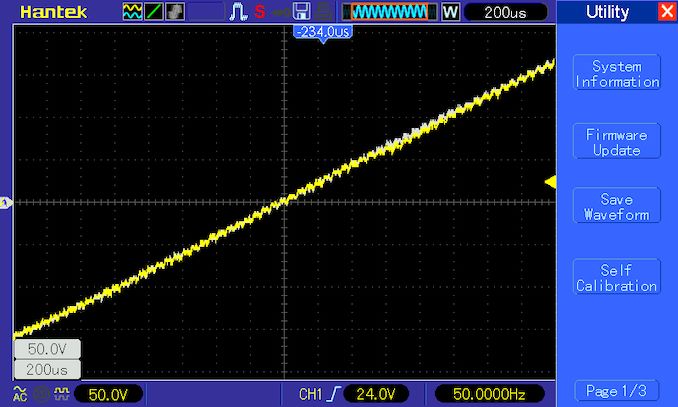
Blue line: Zero load / Yellow line: 1350 Watt load
The Vertiv Edge Lithium-Ion 1500 VA UPS also is exceptionally stable when the load suddenly shifts. The capture below reveals the worst output waveform deformation that we managed to cause while the unit was running on batteries and we had to immediately switch the load from zero to 100% in order to realize it - a completely unlikely real-world scenario.
Conclusion
Vertiv typically designs products for IT infrastructure and industrial sites. With the Edge Lithium-Ion 1500 VA UPS, Vertiv is trying to make a move towards the high-end retail market with a product that was initially designed for critical IT infrastructure, particularly for sites where frequent maintenance may difficult. Due to its intended design, we expected that its electrical performance would outclass more retail-grade products, and the Edge Lithium-Ion 1500 VA UPS did not let us down.
As far as consumer/household use is concerned, the UPS also fares very well there since it's dead-quiet while fully charged and running on AC power. The flip side to that, however, is that the fan can be loud when the UPS needs to charge its batteries. Although Vertiv’s engineers tried to implement a fan speed controller, the application was not brilliant, as the fan still operates at maximum speed most of the time. The saving grace here is the short battery charging time, meaning that the fan will not stay at maximum speed for several hours, as is the case with the vast majority of retail lead-acid UPS designs.
The highlight of this particular UPS obviously is the lithium-Ion battery. A VRLA battery of equal capacity would be almost twice as large and heavy, and as you might expect, Vertiv seems to be bringing that up a lot in their marketing brochures. But these are admittedly not significant advantages for stationary installations.
Rather, the two truly important advantages of using a lithium-Ion battery are its lifetime and charging current. The lithium-Ion battery will live for much longer than a typical VRLA battery and may even outlive the service life of the UPS itself, which is why Vertiv is so comfortable with offering a five-year warranty on the battery. It can also be charged much faster than VRLA batteries, with the Edge Lithium-Ion 1500 VA charging its battery from 10% to full in a little over two hours. This is very important in areas where the electricity supply is unreliable and the UPS needs to keep critical infrastructure, like a security system, communications equipment, or even a medical system, always running. If the load of the UPS is low, the Edge Lithium-Ion 1500 VA can keep equipment running even if the electrical grid is available for less than half of the day.
For the retail consumer, the advantages of owning a UPS like the Vertiv Edge Lithium-Ion 1500 VA are obvious. As the UPS was initially designed to protect critical infrastructure, it goes without saying that its electrical performance is outstanding, with exceptional transfer times and amazing output power quality. The lithium-Ion battery also offers rapid charging-discharging times and has a significantly greater lifetime than typical VRLA batteries. Undoubtedly, the Vertiv Edge Lithium-Ion 1500 VA is an excellent UPS by current standards, with fantastic overall performance and a lengthy warranty.
However, Vertiv is not a company with a strong retail presence, and as a result they seem to have difficulties truly bringing their products down to the high-end consumer market and making them available from more consumer-focused retailers. As such, not only is the retail price of the Edge Lithium-Ion 1500 VA unit well above $1.000 at the time of this review, but its retail availability is also limited, impairing the market potential of the unit. So while it's a fantastic UPS overall, given the high price tag, the only users we can really envision buying an Edge Lithium-Ion unit to begin with are those who need to protect very expensive equipment and/or have to deal with a very low-quality electrical grid. And, for better or worse, there are a number of other top-performance UPSes that are readily available from retailers even when the Edge is not.


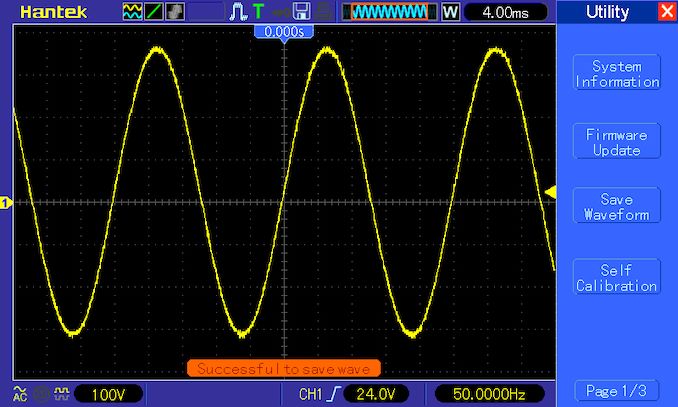

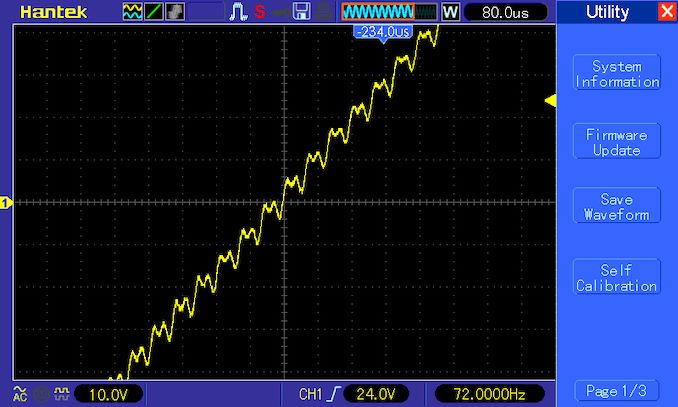
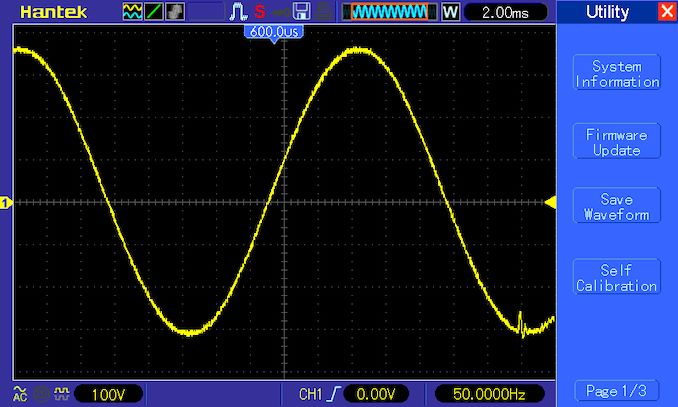
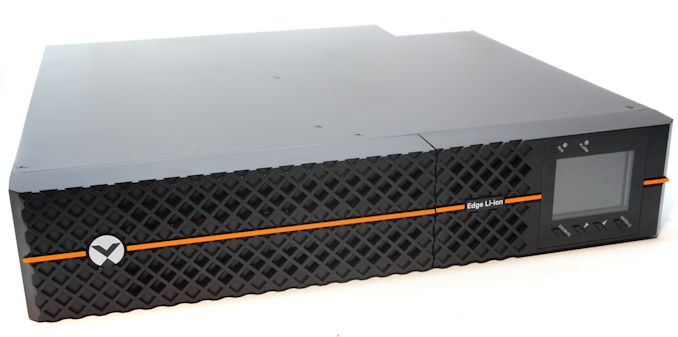
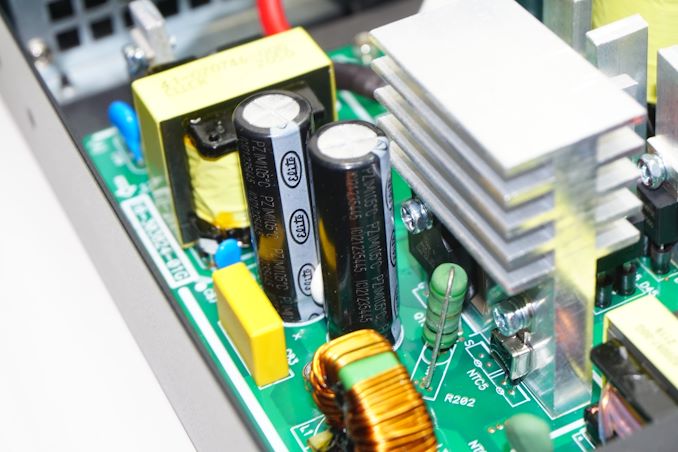
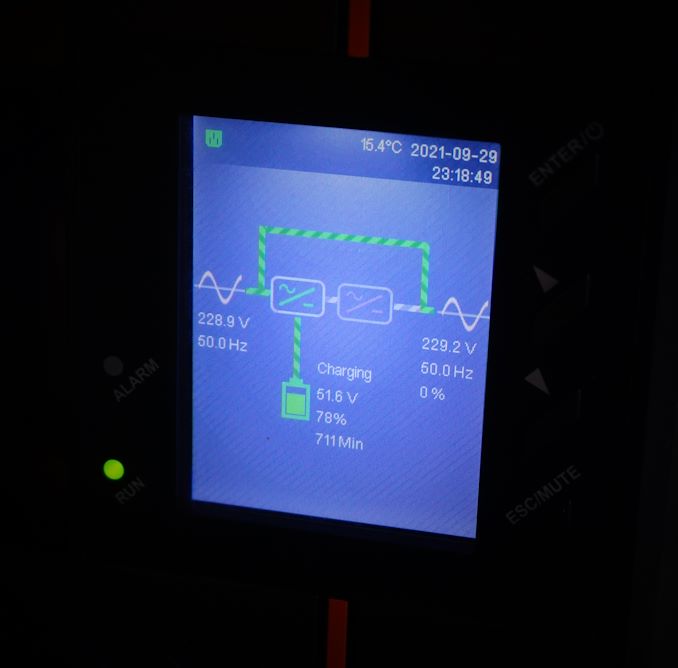








44 Comments
View All Comments
Hresna - Saturday, April 23, 2022 - link
I’ve long wondered why we don’t see UPS systems integrated to desktop power supplies so as to cut down on extraneous AC-DC conversions. It would obviously have to be larger than an tax PSU but you just have it as a breakout the way the UPS is. Laptop batteries keep everything DC… how complex could it be to make a desktop PSU module with an input for DC battery feed….Maltz - Saturday, April 23, 2022 - link
Well, one problem that comes to mind is that your desktop running won't do you much good if your monitors go dark. lol A UPS has to power more than just the computer.Hresna - Saturday, April 23, 2022 - link
Fair enough I suppose. Although if it’s an auto-shutdown situation the monitor would be an additional unneeded load for that operation. Still better and more effective under user control though. I guess It would be more for like headless servers or something like that.TomWomack - Saturday, April 23, 2022 - link
At a company based in a building with a dodgy power supply, having UPSes on the developers' desktops, so that a brief glitch meant that their monitor flickered rather than that all their state in emacs vanished, was a really good move.I found that Apple machines mostly didn't need the UPSes; it was as if they had bigger capacitors in their power supply and could slide over a sub-second outage while our PCs from the local generic component-assembler usually couldn't.
"How long a mains-power drop-out can it tolerate" is a really awkward parameter to test for, but would be really useful to see in reviews of PSUs.
TomWomack - Saturday, April 23, 2022 - link
(this would be about a decade ago - the Apple comment applied both to the big dual-Xeon cheese grater Mac Pros and to the Mac mini, the desktops while I was there went from dual-core Athlon64 to quad-core and six-core Nehalem and Westmere)Gigaplex - Sunday, April 24, 2022 - link
""How long a mains-power drop-out can it tolerate" is a really awkward parameter to test for, but would be really useful to see in reviews of PSUs."This is part of half-decent PSU reviews. The spec you're looking for is hold-up time. The ATX standard has a minimum requirement of 17ms, but many PSUs don't meet that.
t.s - Monday, April 25, 2022 - link
there's monitor with DC in. My workplace use all DC tools- Prodesk 600 G4 / Elitebook 840 g3
- Monitor Samsung S24R
- Router Xiaomi AX1800
- Modem
- 5V charger
All connected to 100A 12.8v LFP.
Hresna - Wednesday, April 27, 2022 - link
Interesting, is there a product name? I’ve searched quickly but the closest thing I found was just a controller card for an application like this but the battery (presumably targeting auto or marine?) would be separatet.s - Wednesday, April 27, 2022 - link
I bought 48v 100Ah SacredSun LFP, dismantle it, and get 4 pcs from there. Sell the rest (11 pcs).I charged it with 12v SMPS -> dc-dc boost to 13.34v. The monitor, modem, router, 5v charger, battery is at the end of dc-dc booster. For laptop/mini-pc that use > 17v, I boost once again to 17v.
*for the battery, if you can source it from China, get something like eve or catl. USA can buy from BattleBorn. BattleBorn LFP has BMS. So, more safe. Mine doesn't have BMS.
Guspaz - Sunday, April 24, 2022 - link
Anker recently announced their first UPS (as you might expect it evolved out of their “PowerHouse” line of AC backup batteries), which has a roughly similar cost to this unit, somewhat higher load support, and nearly seven times the runtime… I don’t know if 8.7 minutes of runtime is acceptable when Anker’s will do about an hour for the same cost. However, the Anker advertises a 20ms switch time, which implies a standby topology, not line interactive like this one.